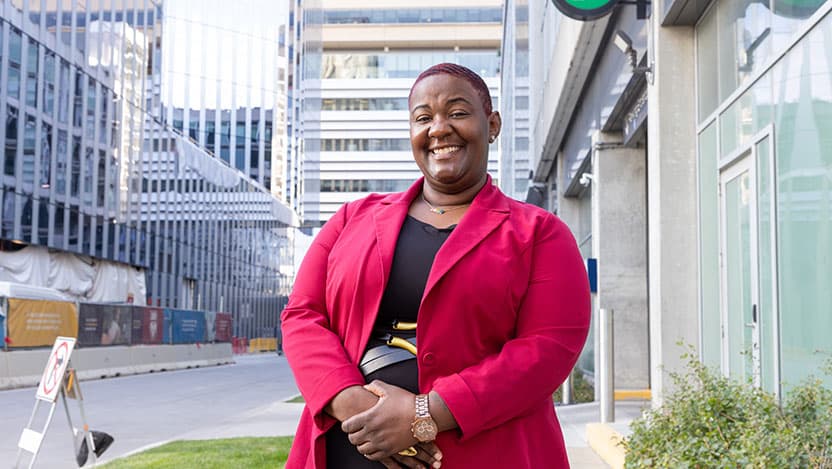Improving access to care: patient advocate program celebrates 20 years

As a volunteer for the University of Chicago Medicine's Hospital Welcome and Wayfinding Volunteer Program, Hyde Park resident Claudia Kemp is used to helping visitors find their way at the Duchossois Center for Advanced Medicine. She usually sits in front of the elevators at the second-floor lobby, scanning people's faces to see who needs directions or a hospital map.
“I can tell if you look like you need some help,” said the retired Chicago Board of Education worker.
In January, however, it was Kemp who received some navigational help from UChicago Medicine: specifically, the Medical Home and Specialty Care Connection (MHSCC) program, an initiative helping Emergency Department (ED) patients find primary and specialty care and schedule follow-up appointments. The program is celebrating its 20th anniversary this year and has helped facilitate tens of thousands of follow-ups for patients.
After feeling unwell at home, Kemp was brought by ambulance to the ED, where her vital signs were checked. Shortly after, MHSCC patient advocate Marquita McCarter stopped by Kemp's bedside and helped arrange a follow-up appointment with a UChicago Medicine cardiologist.
“I think it's just great to have someone who can assist with that navigation through the health system,” said McCarter. “Healthcare can be a very tough onion to peel.”
A program to help connect patients to care
The South Side of Chicago is a culturally diverse and historic set of neighborhoods that is also home to numerous underserved and marginalized communities. Decades of systemic inequality and economic disinvestment contribute to a disproportionate number of residents dealing with chronic conditions like hypertension and diabetes.
The program is one of several initiatives and partnerships managed by the Urban Health Initiative (UHI), UChicago Medicine's community health division. Aimed at improving the health of local communities and connecting people to needed support services, the UHI was started in 2005 by UChicago Medicine officials including Michelle Obama, who was then vice president for community and external affairs.
MHSCC patient advocates like McCarter spend part of their time educating clients on the importance of developing and maintaining a relationship with a care team so they can get the care they need at the right time and place. Since 2010, MHSCC patient advocates have worked with more than 94,000 patients, facilitating more than 83,000 follow-up care appointments.
“The emergency room is like a Band-Aid, but we want to know what's at the root cause (of our patients' health issues),” said McCarter, who provides services both in-person and over the phone.
About 17% of all patients passing through the Medical Center’s ED are assisted by the MHSCC, regardless of their insurance status.
Patient advocates spend roughly a week working with individual patients and often work closely with the South Side Healthy Community Organization — a state-funded network that includes UChicago Medicine, four community hospitals, health system partners like St. Bernard Hospital and South Shore Hospital, and six federally qualified health centers on the South Side. Each site has community health workers who communicate on the same health platform to ensure patients don’t fall through the cracks. Patients are also referred to UHI internal programs like the Liaisons in Care program, which helps fund community health workers at community organizations.
“If we identify patients in the ED who need additional longer-term support — say they’re experiencing homelessness, food insecurity or need help managing a chronic disease — we connect them to partner programs that use community health workers to address those needs, alongside their providers,” said Melanie Francia, MPH, MHSCC’s patient advocate manager. “That support can continue whether it’s here at UChicago Medicine or at a partner clinic site.”
Patient advocates also provide patients with the simple support of another person's presence in the ED.
“It makes the experience you're already nervous about more comfortable because otherwise, you're sitting there by yourself, waiting until you get (test) results, not knowing what it could be,” said Kemp. “They made me feel comfortable.”
The MHSCC program has modernized and expanded since it began. When it first started 20 years ago, ED physicians were still writing sticky notes to enlist the help of patient advocates. Today, those referrals are all done through patients' electronic health records. Since 2010, the program has grown from six patient advocates to 12.
A financially self-sustaining initiative
The cost of the program is offset by the healthcare expenses it helps avoid. A recent study by UChicago Medicine researchers found the program helped substantially reduce the number of repeat ED visits made for minor or non-urgent medical issues.
Published in June in the Western Journal of Emergency Medicine, the study revealed that minor or non-urgent ED visit rates decreased 45% after patients were provided assistance with scheduling primary and specialty care appointments, healthcare access resources, and healthcare navigation education.
By preventing an estimated 9,447 visits, the program reduced healthcare spending by about $2.9 million over nine years.
“The program is designed to benefit the community, but another advantage is that it ends up paying for itself,” said epidemiologist Mitchell Hoyer, MPH, the study's first author.
